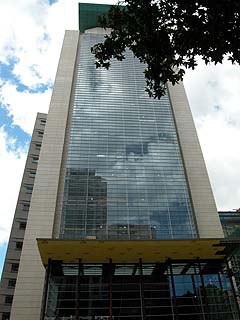
Surveys
AIA Awards
DJC.COM
November 20, 2003
Unwrapping modern building envelopes
Weber + Thompson

Rendering by Weber + Thompson
The design of the proposed Colman Tower in Seattle calls for a state-of-the-art curtain wall composed of high-performance glass and panelized brick. |
The advent of the curtain wall is one of the most influential developments in the history of modern architecture.
Conventionally, the perimeter walls of a structure support the vertical loads of a building. Conversely, a curtain wall cladding system is a continuous vertical “curtain” of glass or stone that does not provide structural support, and is in fact itself supported by imbeds or supports at the face of a concrete or steel frame floor slab. By adding more vision glass to exterior wall, the curtain wall affords more light and more substantial views, which makes for a more pleasant work and live experience.
A paradigm shift
The earliest curtain wall appeared in 1918 when new steel frame and fenestration technology afforded this liberation of skin from structure.
While designing the Hallidie Building in San Francisco, Architect Willis Polk came up with the radical idea that a contiguous, non-load-bearing exterior glass wall could be constructed at the face of the entire building.
Polk was not only ahead of his time, he was also ahead of modern environmental controls and something called air conditioning that we all take for granted! As one might guess, his building was not very popular on sunny days, but we certainly owe thanks to Polk for his pioneering invention that brought about a paradigm shift in our thinking about exterior cladding for high-rises.
Of course, widespread use of curtain wall design did not come to fruition until the 1950s when insulated glazing, conditioned air and insulation technologies were available to offset the widely variable heating and cooling loads that come with increased vision glass.
The modern curtain wall
Today's curtain wall is the heart and soul of the modern high-rise building envelope. Contemporary high-rise buildings are constructed of innovative and highly efficient curtain wall systems comprised of light-weight glass, stone, aluminum, marble, metal or composite assemblies — the architectural and aesthetic possibilities are almost unlimited. These systems are designed to limit air and water infiltration by equalizing the substantial wind pressures which high-rise buildings are subjected to. When designed properly, they are aesthetically beautiful and highly functional in keeping the elements out and the temperate environment in.
Curtain wall systems and water intrusion
The primary function of a building envelope is to protect against water intrusion. There are four basic curtain wall systems in play today that are designed to help ensure building envelope integrity:
-
1. The barrier system seeks to keep water completely outside the envelope. This system has no redundancy or additional line of defense to deal with water that infiltrates the barrier. Since it is almost a foregone conclusion that at least some water will get into the system and must be able to drain back out, the barrier system is not recommended in a marine environment like the one we enjoy in Seattle.
2. The drainage system has an additional line of defense, capturing and releasing water that enters the system through a drainage channel.
3. The new kid on the block is the rainscreen system, which has a redundant, pressure-equalized waterproofing barrier — effectively an air space that reduces pressure drive.
4. Another innovative curtain wall system is the “bio-climate” double curtain wall, whereby two glazed walls are constructed with a 1- to 3-foot space between. In these “green” buildings, computer-controlled and user-interfaced devices may be integrated into the curtain wall system in order to encourage the use of fresh air and natural day-lighting, while at the same time improving user comfort, reducing energy consumption, and promoting a sustainable solution.
Although the benefits of this system are primarily energy related, the redundant second glazed wall also provides effective protection from water infiltration. This system is being promoted as the wave of the future. It is widely used in Europe — where the cost of energy is substantially higher — justifying the additional expense through efficient life-cycle costing.
What could possibly go wrong?
The curtain wall is such an elegant concept, what could possibly go wrong with such a great idea? When they work as intended, curtain walls prevent the infiltration of water and air leakage while allowing for more transparency and a spectacular array of cladding options.
But when curtain walls fail, the results are often dramatic and disastrous. Glass or stone panels can fall off and endanger lives below, water infiltration can accelerate degradation of the skin and structure of a building, incompatibility of materials can cause electrolysis or disintegration, and building envelopes may need wholesale replacement — the cost for which can sometimes exceed the cost of building the entire original project.
Poorly designed or improperly installed curtain walls leave a trail of litigious misery that take years and sometimes millions of dollars to diagnose and repair.
What causes curtain wall failure?

Photo by Benjamin Minnick
The new U.S. Courthouse by NBBJ Architects is one of the first buildings in Seattle to have low-iron glass for its full facade. The high-security building also has a redundant structural system designed to withstand a significant bomb blast.
|
Curtain-wall problems can result from poor design, product failure, deficient installation, or a devastating combination of all three. In high-rise buildings, it is well established that negative wind pressures — especially at the top corners of a building — can be highly problematic. However, research indicates that curtain walls that are going to fail do so long before extreme wind loads are applied. In other words, more often than not, curtain wall failure is attributed to fundamental deficiencies that occur even at zero wind-load.
Although in many cases, product failures and deficient installation are to blame, most curtain wall failures happen at the drawing board, generally the result of these problem areas:
-
1. Failure to accommodate required tolerances for deflection and building movement.
2. Poorly designed interface conditions where diverse and sometimes chemically inappropriate materials are married or where flashings have not been properly designed.
3. Sealant adhesion failures or over-reliance on sealants.
4. Failure to properly test and to then modify design details in response to field or laboratory-tested assemblies.
5. Failure to install properly.
Building tolerances
Buildings expand, contract and move in response to live loads, wind, earthquake, temperature, freeze-thaw cycles and other forces. Inter-floor story drift can actually twist panels into the shape of a parallelogram. Curtain wall elements must absorb, transfer and withstand wind and temperature loads through carefully designed vertical and horizontal support elements.
Thermal expansion/contraction of the curtain wall components and the differential inter-floor deflection requires attention in order to ensure that joints can withstand as much as 3/8” of deflection across a typical spandrel beam. The fasteners that hold these elements together require careful scrutiny due to the potential long-term fatigue.
Interface conditions, sealants and flashings
Forensic waterproofing experts and materials scientists often point out that many curtain wall problems occur where divergent materials intersect. Materials that are not suitable for contact can react chemically, creating materials degradation. Poor flashing details such as a lack of proper end dams, lack of counter flashing, sealant adhesion failures or improper weeps, will result in water infiltration contributing to a plethora of problems ranging from sheet rock-fastener corrosion, loosening of mortar joints, the loss of insulation value due to the wetting of the insulation material, the sick air building problem due to the growing of toxic molds in the wall cavity, and even structural failure.
Sealant joints and gaskets that are not designed to absorb shear distortion with sufficient horizontal clearance between adjacent construction elements can lead to structural failure of curtain wall panels in the form of buckling in metal panels or broken glass falling from the sky.
Last but not least, staining can occur when sealants are not compatible.
Testing
Every curtain wall building is a unique and innovative marriage of glass, metals, stone and sometimes high-tech materials such as aluminum panels or thin stone veneer panels. All of these unique assemblies must be ASTM-tested by a certified agency both in the lab and in the field in order to ensure building envelope integrity. Architects must resist pressure from owners and contractors to short change this vital process, which is essential for ensuring long-term building performance.
It's all in the details
Although in many cases product failure or improper installation is to blame, most curtain wall failures result from poor design. In order to ensure the integrity of the curtain-wall building envelope, a design team must ensure: there are proper construction tolerances; extraordinary attention be paid to construction details at interface conditions and at sealants, flashings and weeps; and, perhaps most important, unique assemblies must be properly tested and final details refined in response to any weaknesses detected.
Best efforts and due diligence in all of these areas will help to ensure project success — it truly is in the details.
Blaine J. Weber, AIA, is a founding partner at Weber + Thompson of Seattle — a diversified architecture, interior design and planning firm specializing in high-rise office and residential structures.
Other Stories:
- Today's buildings load up on technology
- Letting rainwater reign in the design process
- Church praises the benefits of adaptive re-use
- UW builds on design leadership training
- Science studies how architecture affects the brain
- China creates a park with environmental appeal
- How the Great Fire changed Seattle's architecture
- Architects play catch-up in the business world
- Designing with nature in the balance
- 12 keys to creating authentic people places
- Monorail to move urban design as well as people
- Water tower repairs borrow on building technology
- Technology takes center stage in performance halls
- Don't be violated — protect plans with copyrights
- Special dampers may shake up engineering field
- UW Allen Center fosters a culture of research
- Here's why projects need to be commissioned
- Lessons on sustainability, Scandinavian style
- Building a highrise on the fault line
- How to keep development from killing trees
- Rx for changing healthcare industry: Good design
- In hospitals, spending more can save money
- Muckleshoot project blends culture with design
Copyright ©2009 Seattle Daily Journal and DJC.COM.
Comments? Questions? Contact us.